An old-fashioned beef stew recipe is the perfect cool-weather comfort food. Tender chunks of beef simmered in a rich flavorful gravy, and of course, loaded all the right vegetables.
This is the classic recipe my Grandma taught me to make. No wine!! (This is American beef stew, not French). Just incredible, thick brown gravy. And, as an added bonus, the house smells amazing while this pot of amazing stew simmers away.
Stew is one of the best autumn dinners. Whether you have something unique like Brunswick stew or chicken stew, or a quick meal-saver like Instant Pot beef stew, Slow Cooker Beef Stew, the end result is always the same: satisfied appetites, happy family!
Let’s make this amazing stew!
What I Love About This Beef Stew Recipe
- Hearty, tender beef
- Perfect rich gravy
- Warms you through and through
- Ultimate cold-weather meals!
Beef Stew Ingredient’s List
- Beef Chuck
- Salt
- Pepper
- Vegetable Oil
- Yellow Onions
- Garlic
- All-purpose Flour
- Low-sodium Beef Stock
- Better Than Bouillon, Beef Flavor
- Tomato Paste
- Worcestershire Sauce
- Bay Leaves
- Sweet Paprika
- Thyme Leaves
- Granulated Sugar
- Carrots
- Russet Potatoes
- Frozen Peas
Beef Stew Recipe Notes
- Beef: For stew in general, chuck roast is a perfect choice. It creates a rich mouth-feel and becomes meltingly tender during the long, low cooking process.
- Aromatics: As with most beef stew recipes, you can’t skip sautéing the aromatic vegetables before adding them!
- When these veggies are raw, they contain compounds that are pungent and sulfurous—not what you want in your soup. But when those same vegetables are heated, the compounds change, evolving into something sweet and wonderful!
- Brown Bits: When you brown the beef in the oil, you create brown bits, called fond, at the bottom of the pot. These are flavor gold.
- You want to make sure there’s enough oil and that you moderate the heat while browning so the fond becomes deeply colored but does not burn.
- In many recipes, the liquid is added and brought to a boil after the browning to release the fond from the pan so it can be incorporated into the sauce. In this recipe, I sauté the onions and garlic instead. The vegetables release their natural liquids and do a perfect job of loosening the brown bits.
- Don’t be alarmed when the onions take on a deep brown color. It’s just the fond goodness coating them.
- Garlic: I like to rough chop garlic rather than mince it. Because the pieces are larger, I sauté them with onions without worrying they’ll burn. If you prefer minced garlic, add them to the onion for the last few minutes of the sauté and stir frequently.
- Potatoes: I always make this beef stew recipe with russet potatoes. What’s the difference between russet potatoes and other kinds? Russet potatoes have some of the highest starch content, which means they break down very well when cooked in soups and stews to help further thicken the broth.
How To Thicken Beef Stew
The flour the beef is dredged in and the russet potatoes thicken this stew nicely. In fact, I would go further to say, perfectly. If for some reason your stew doesn’t thicken as expected, I suggest a cornstarch slurry.
A cornstarch slurry is 2 parts cold water and 1 part cornstarch. I would suggest mixing 2 tablespoons of cornstarch to 1/4 cup cold water with a fork. Stir half the mixture into the stew. Bring to a boil and allow to boil for at least 1-2 minutes to cook out the starchy flavor. If the stew thickness isn’t to your liking, add the remaining slurry. Bring to a boil and simmer. Don’t overcook because the starch may break down and the stew will thin out again.
Storing + Freezing + Make Ahead
- How Long Can You Keep This In The Fridge? Once cooked, you can store the stew in the fridge for up to four days.
- Can You Freeze This? You can certainly freeze this stew recipe and keep ready-made meals in the freezer. It works best if you store it in a size-appropriate air-tight container.
- Just remember to leave room for expansion and make sure that it is completely cooled before placing your beef stew in the freezer.
- Make-Ahead Tips: Creating this recipe ahead of time will just ensure that it has a superior flavor and it’s ready when you are. This recipe will taste even better the next day after marinating in that incredible sauce.
- Food Safety: If you’d like more food safety info check out this article.
What To Serve With Beef Stew
The only way to serve beef stew is with lots and lots of delicious, fluffy, homemade BREAD! Lion House rolls are a classic and always a winner. I can never make enough to satisfy my family’s cravings!
My magically simple, no-knead bread, Bisquick biscuits, or beer bread are all delicious choices!
More Comforting Stew Recipes
Here are my favorites!
- Cowboy Stew
- Pork Stew
- Shipwreck Stew
- Hamburger Stew
- German Goulash
- Hungarian Goulash
- Guinness Beef Stew
- Meatball Stew
- Green Chile Stew
Beef Stew Recipe
Ingredients
- 3 pounds beef chuck, cut into 1 inch cubes
- 1 1/2 teaspoons salt
- 1 teaspoon pepper
- 3-4 tablespoons vegetable oil
- 2 cups yellow onions, chopped
- 1 tablespoon garlic, minced
- 1/4 cup all-purpose flour
- 6 cups low sodium beef stock
- 1 heaping tablespoon Better Than Bouillon, beef flavor
- 2 tablespoons tomato paste
- 2 teaspoons Worcestershire sauce
- 2 bay leaves
- 1/2 teaspoon sweet paprika
- 1/2 teaspoon thyme leaves
- 1 teaspoon granulated sugar
- 4 large carrots, peeled and cut into 1-inch chunks
- 2 large russet potatoes, peeled and cut into 1-inch chunks
- 1 cup frozen peas, thawed
Instructions
- Remove any excess moisture on beef cubes (3 pounds) with paper towels. Place in a large mixing bowl and toss with salt (1 1/2) and black pepper (1 teaspoon).
- In a large heavy-bottom pot, over medium-high heat, heat 2 tablespoons of oil until it shimmers. Brown the meat in 3 batches on all sides, about 5 minutes per batch. (Do not crowd the pan or the beef will simmer rather than brown and you won't create any fond.) Remove browned beef to a plate; set aside. Repeat with the remaining beef, adding more oil as needed.
- Add onions (2 cups) and garlic (1 tablespoon) to the pot and saute until almost soft, about 5 minutes. Sprinkle flour (1/4 cup) over the top of the vegetables and continue to cook for 1-2 minutes to reduce the flour flavor.
- Add beef stock (6 cups), better than bullion (1 heaping tablespoon), tomato paste (2 tablespoons), Worcestershire sauce (2 teaspoons), bay leaves (2), paprika (1/2 teaspoon), thyme (1/2 teaspoon), and sugar (1 teaspoon). Return browned beef and any juices that have accumulated on the plate to the pot. Bring to a boil, then reduce heat and gently simmer until the beef is tender about 1 1/2 hours.
- Add the carrots (4) and potatoes (2) and simmer until tender. Add the peas (1 cup), remove from the heat, cover, and let sit for 5-7 minutes. Adjust seasoning, garnish with parsley or fresh thyme, and serve.
Fans Also Made:
Notes
- Beef: For stew in general, a chuck roast is a perfect choice. It creates a rich mouth-feel and becomes meltingly tender during the long, low cooking process.
- Aromatics: As with most beef stew recipes, you can’t skip sautéing the aromatic vegetables before adding them!
- When these veggies are raw, they contain compounds that are pungent and sulfurous—not what you want in your soup. But when those same vegetables are heated, the compounds change, evolving into something sweet and wonderful!
- Brown Bits: When you brown the beef in the oil, you create brown bits, called fond, at the bottom of the pot. These are flavor gold.
- You want to make sure there’s enough oil and that you moderate the heat while browning so the fond becomes deeply colored but does not burn.
- In many recipes, the liquid is added and brought to a boil after the browning to release the fond from the pan so it can be incorporated into the sauce. In this recipe, I sauté the onions and garlic instead. The vegetables release their natural liquids and do a perfect job of loosening the brown bits.
- Don’t be alarmed when the onions take on a deep brown color. It’s just the fond goodness coating them.
- Garlic: I like to rough chop garlic rather than mince it. Because the pieces are larger, I sauté them with onions without worrying they’ll burn. If you prefer minced garlic, add them to the onion for the last few minutes of the sauté and stir frequently.
- Potatoes: I always make this beef stew recipe with russet potatoes. What’s the difference between russet potatoes and other kinds? Russet potatoes have some of the highest starch content, which means they break down very well when cooked in soups and stews to help further thicken the broth.

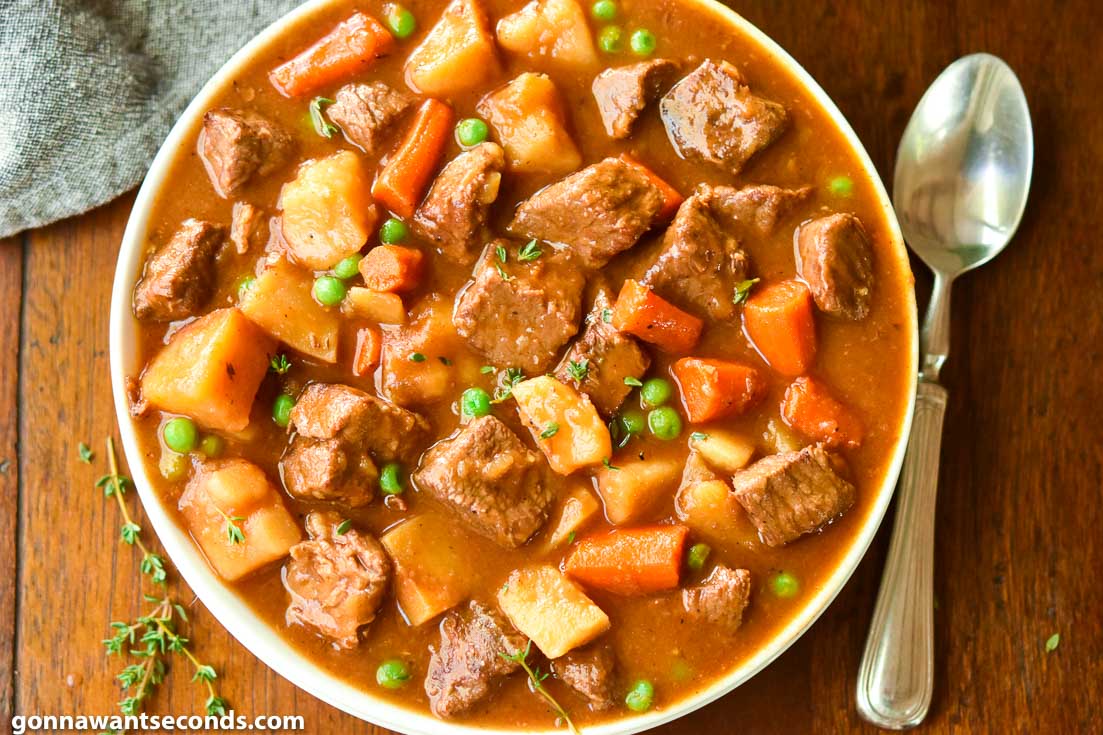
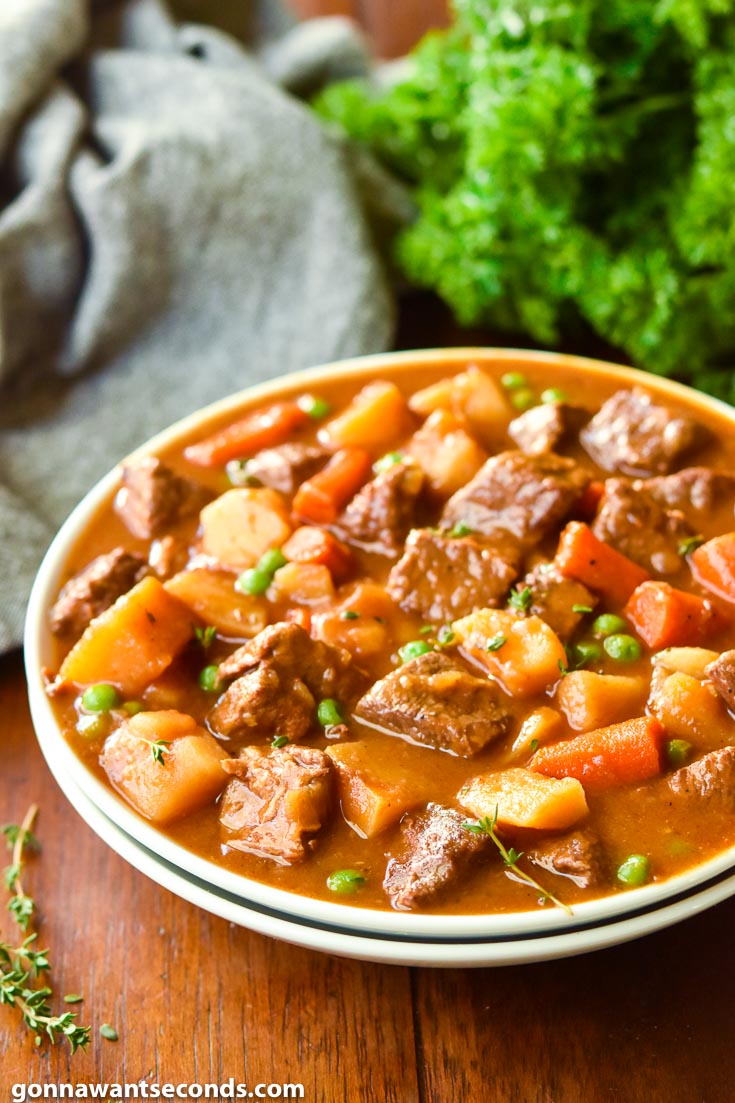

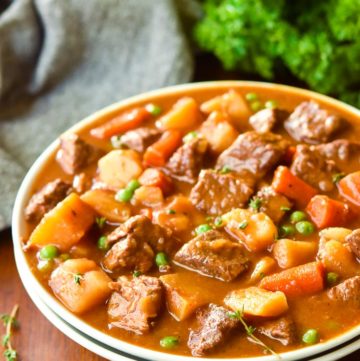
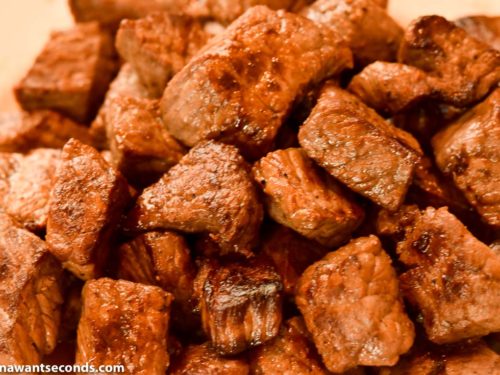
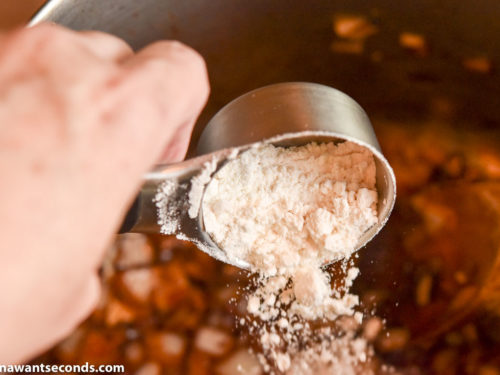
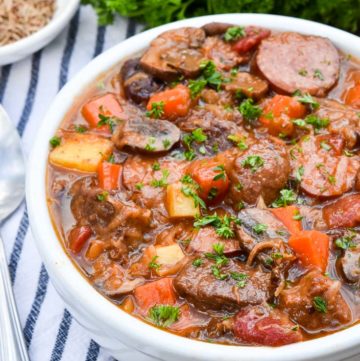
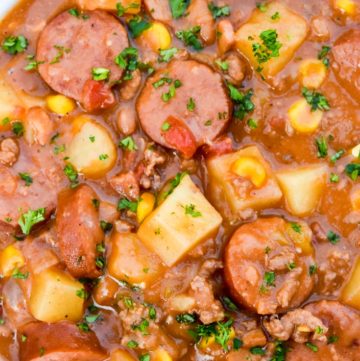
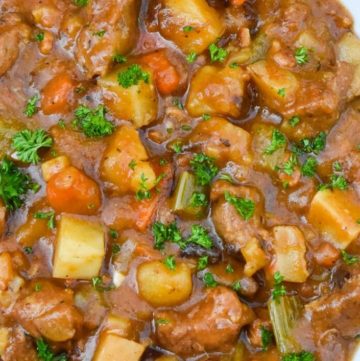
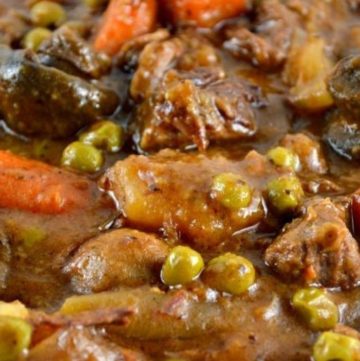


This beef stew was excellent, making me go back for seconds. Positively delicious!
My family loved this stew!